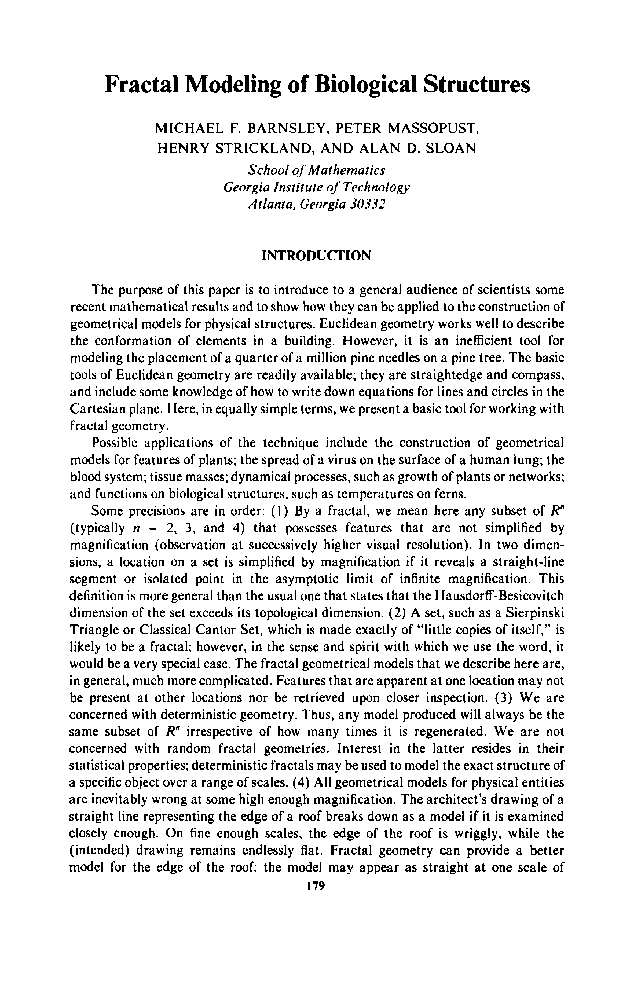Fractal Image Encoding
http://rd.springer.com/chapter/10.1007/978-1-4613-0727-3_1
Chapter Unconventional Photoactive Solids Part of the series Institute for Amorphous Studies Series pp 1-10 Fractal Image Encoding M. F. Barnsley, J. H. Elton, A. D. Sloan, H. Strickland
Abstract:
Increasingly, the output of physical and numerical experiments is presented as two dimensional images, instead of as tables and graphs of observed real variables. Instances include pictures of diffusion limited aggregates, fractal fingering boundaries between fluids, and images of turbulent flows. One approach to understanding the intricate geometries of such experimental data is traditional: try to isolate physically meaningful real parameters, such as fractal dimension (Mandelbrot, 1982), by passing straight lines through data points derived from the pictures. Another approach is to attempt to approximate the image with a geometrical entity whose structure is, despite appearances, quite simple. Straight lines, squares, circles and other fundamentally Euclidean models will not suffice for this purpose when the data possesses structure which cannot be fully resolved or simplified by rescaling (i.e., magnification). The first purpose of this paper is to describe in simple terms how fractal geometries may be succinctly understood in terms of iterated function systems and to explain how one can go about finding a fractal model to fit given two dimensional data. The second purpose is to relate attractors for iterated function systems to attractors for cellular automata (Wolfram, 1983). The latter is motivated by the following question: Once one has found an iterated function system encoding of an image, can one deduce a set of cellular automata rules which would allow one to construct the image of a lattice? The answer is “Yes”, which delights us for this reason. For some time, via the Collage Theorem (Barnsley, et al., 1984), one has known how to make iterated function system models for ferns and leaves; now one may also model the manner in which these forms both grow and stop growing.
References:
Barnsley, M. F. and Demko, S. G., 1985, Iterated function systems and the global construction of fractals, Proc. Roy. Soc. Lond., A399, 243–275
Barnsley, M. F. and Demko, S. G., Elton, J. H.,and Geronimo, J. S., 1985, On the and attractiveness of invariant measures for iterated function system, preprint.
Barnsley, M. F., Ervin, V., Hardin, D., and Lancaster, J., 1984, Solution of an inverse problem for fractals and other sets, to appear P.N.A.S.
Dubins, L. E. and Freedman, D. A., 1966, Invariant probabilities for cer-tain Markov processes, Ann. Math. Stat. 32, 837–848.
Demko, S., Hodges, L., and Naylor, 1985, Construction of fractal objects with iterated function systems, Computer Graphics 19, 271–278.CrossRef
Diaconis, P. and Shashahani, M., 1984, Products of random matrices and computer image generation, Stanford U. preprint.
Hutchinson, J., 1981, Fractals and self-similarity, Indiana U. Journal of Math. 30, 713–747.
Mandelbrot, B., 1982, “The Fractal Geometry of Nature,” W. H. Freeman, San Francisco.
Wolfram, S., 1983, Statistical mechanics of cellular automata, Reviews of Modern Physics, 55, 601–644.
Fractal Modeling of Biological Structures
http://65.54.113.26/Publication/55362870/fractal-modeling-of-biological-structures [ Microsoft Academic Search ]
Michael F. Barnsley, Peter Massopust, Henry Strickland, Alan D. Sloan
Database: Astronomy Physics arXiv e-prints
Journal: Annals of The New York Academy of Sciences - ANN N Y ACAD SCI , vol. 504, pp. 179-194, 1987
DOI: 10.1111/j.1749-6632.1987.tb48732.x
http://adsabs.harvard.edu/abs/1987NYASA.504..179B
Title: Fractal Modeling of Biological Structures Authors: Barnsley, Michael F.; Massopust, Peter; Strickland, Henry; Sloan, Alan D. Publication: Annals of the New York Academy of Sciences, vol. 504, issue 1 Perspectives , pp. 179-194 Publication Date: 07/1987 Origin: CROSSREF DOI: 10.1111/j.1749-6632.1987.tb48732.x Bibliographic Code: 1987NYASA.504..179B
http://onlinelibrary.wiley.com/doi/10.1111/j.1749-6632.1987.tb48732.x/abstract

Fractals Everywhere
Michael F. Barnsley, Hawley Rising
Morgan Kaufmann, 2000
http://books.google.com/books/about/Fractals_Everywhere.html?id=oh7NoePgmOIC
I'm not an author, but two images made by me are in the book, including the "Fractal Orchid" I made for a Christmas Card one year.